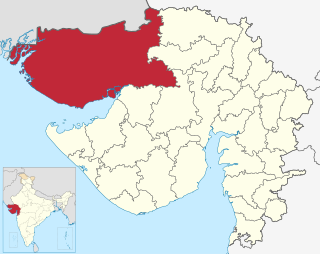Alfred High School in Bhuj, Kutch is one of the oldest educational institution of Gujarat and first high school of Kutch. It was founded by Rao of Cutch, Pragmalji II in year 1870 at cost of ₹150,000 (US$1,900). The school was named Alfred High School, after Prince Alfred, the Duke of Edinburgh.
Desalpar Gunthli is a village and site belonging to Indus Valley civilisation located at Nakhtrana Taluka, Kutch District, Gujarat, India. Desalpar is approx 25 km away from Bhuj. This site is of modest dimensions,(130 m by 100 m ) situated on the northern banks of once depredatory (erosive) stream, Bamu-Chela, an affluent of the Dhrud river.
Adesar is a small village in Kutch district, Gujarat, India.
Amrapar is a village in Kutch district, Gujarat, India.
Dinara is a village near Bhuj of Kutch district of Gujarat, India.

Gundiyali is a village near Mandvi of Kutch district of Gujarat, India.
Jara is a village near Bhuj in Kutch district of Gujarat, India.
Morgar or Morgad is a village in Nakhatrana Taluka of Kutch district of Gujarat, India.
Pipar is a village in Lakhpat Taluka of Kutch district of Gujarat, India.
Mithi Rohar or Rohar is a village in Gandhidham Taluka of Kutch district of Gujarat, India.

Vira is a village in Anjar Taluka in Kutch district of Gujarat, India. Nearby temple of Jogninar is place of religious significance.
Maharajadhiraj Mirza Maharao Bharmalji II was the Rao of Cutch belonging to Rajput dynasty, who ascended the throne of Princely State of Cutch one month after the death of his father Rayadhan III.
Rao Rayadhan III was the Rao of Cutch belonging to Jadeja Rajput dynasty, who ascended the throne of Princely State of Cutch in 1778 and ruled until 1786 when he was deposed. He again ruled as titular head under council of Bar Bhayat ni Jamat from 1801 to 1813.
Bar Bhayat ni Jamat was a council of twelve members which managed Cutch State under titular kings Prithvirajji from 1786 to 1801 and under Rayadhan III from 1801 to 1813. The council was chiefly led by Fateh Muhammad during both period. The council is also known as Bar Bhayyat or Bar Bhaya.

Fateh Muhammad was a regent who administered Cutch State as a leader of Bar Bhayat ni Jamat under titular kings, Prithvirajji and Rayadhan III.
Rao Godji II, was the Rao of Cutch belonging to Jadeja Rajput dynasty, who ascended the throne of Princely State of Cutch in 1760 and ruled until 1778 when he died. During his rein, the state was invaded by Kalhoras and Talpuras of Sindh several times.

Rao Lakhpatji, also known as Lakhaji, was the Rao of Cutch belonging to Jadeja Rajput dynasty, who ruled Princely State of Cutch as a regent from 1741 to 1752. Later succeeded his father Deshalji I in 1752 and ruled until his death in 1760.
Captain James MacMurdo was the first political resident of British East India Company to Cutch State. He played important role in bringing kutchh under British suzerainty.

The history of Kutch, (kachchh) a region in the extreme west of the western Indian state of Gujarat, can be traced back to prehistorical times. There are several sites related to Indus valley civilization in region and is mentioned in Hindu mythology. In historical times, Kutch is mentioned in Greek writings during Alexander. It was ruled by Menander I of Greco-Bactrian Kingdom which was overthrown by Indo-Scythians followed by Maurya Empire and Sakas. in the first century, it was under Western Satraps followed by Gupta Empire. By fifth century, Maitraka of Valabhi took over from which its close association with ruling clans of Gujarat started. Chavdas ruled the eastern and central parts by seventh century but then came under Chaulukyas by tenth century. After fall of Chaulukya, Vaghelas ruled the state. Following conquest of Sindh by Muslim rulers, Rajput Samma started moving southwards to Kutch and ruled western regions initially. By tenth century, they controlled significant area of Kutch and by thirteenth century they controlled whole of Kutch and adopted a new dynastic identity, Jadeja.
Suigam was a village in Vav Taluka of Maratha Riyasat in Gujarat, India, but it is now a Taluka of Banaskantha district in Gujarat.







